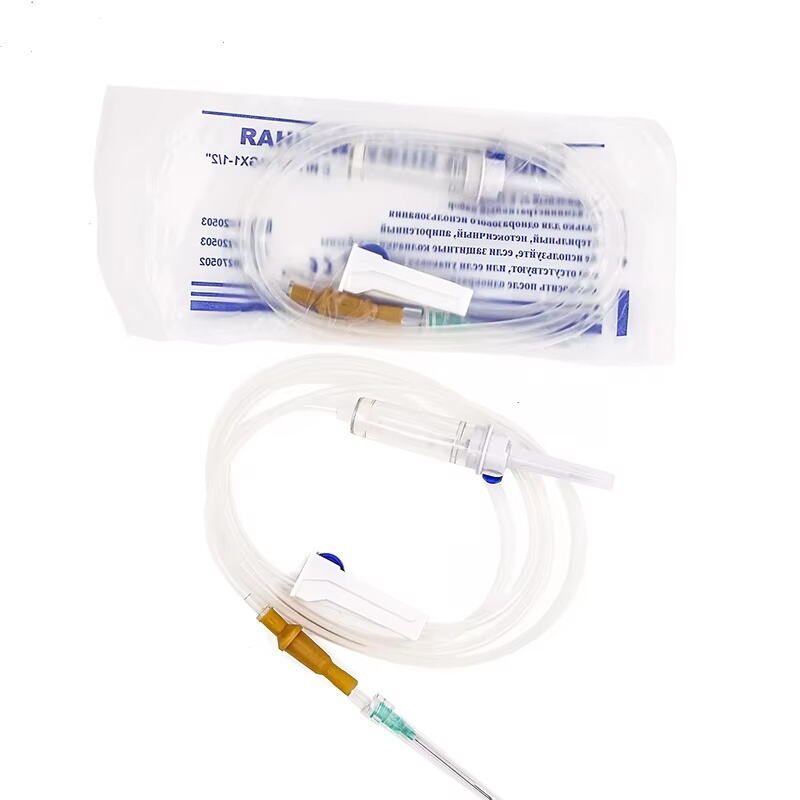Understanding the Critical Role of Modern Medical Infusion Technology
Infusion sets represent one of the most vital components in modern medical care delivery systems. These seemingly simple devices serve as the crucial link between patients and their prescribed medications, playing an indispensable role in delivering life-sustaining fluids, medications, and nutrients directly into the bloodstream. The importance of infusion sets extends far beyond their basic function, encompassing patient safety, treatment efficacy, and healthcare efficiency.
In today's advanced medical landscape, healthcare providers rely heavily on infusion sets to administer everything from basic hydration solutions to complex chemotherapy drugs. Their significance has only grown with the increasing complexity of medical treatments and the rising demand for precise, controlled medication delivery methods.

The Fundamental Components of Infusion Sets
Essential Parts and Their Functions
Modern infusion sets consist of several carefully engineered components working in harmony. The primary tubing, made from medical-grade materials, provides the main pathway for fluid delivery. Drip chambers help regulate flow and prevent air bubbles from entering the line. Roller clamps and flow regulators offer precise control over administration rates, while injection ports enable additional medication administration without compromising the closed system.
Each component undergoes rigorous testing and quality control to ensure optimal performance and patient safety. The materials used must meet strict biocompatibility standards, resist kinking, and maintain structural integrity throughout the duration of therapy.
Advanced Features for Enhanced Safety
Contemporary infusion sets incorporate sophisticated safety features that weren't available in earlier generations. These include anti-free flow mechanisms that prevent accidental gravity flow, needle-free connectors that reduce the risk of needle stick injuries, and air-eliminating filters that protect patients from air embolisms. Back-check valves prevent retrograde flow, maintaining the integrity of the medication delivery system.
The integration of smart technology has further enhanced safety features, with some infusion sets now including electronic monitoring capabilities that can detect occlusions, air bubbles, or irregular flow patterns in real-time.
Clinical Applications and Versatility
Diverse Medical Settings
Infusion sets serve essential roles across various healthcare settings, from intensive care units to home care environments. In hospital settings, they facilitate the delivery of multiple medications simultaneously, support critical care interventions, and enable long-term therapeutic treatments. Ambulatory care centers utilize specialized infusion sets for outpatient procedures and treatments, while home healthcare providers rely on user-friendly versions for continued care outside clinical settings.
The adaptability of modern infusion sets allows healthcare providers to customize delivery systems based on specific patient needs, treatment protocols, and environmental conditions.
Specialized Treatment Applications
Different medical treatments require specialized infusion sets designed for specific purposes. Oncology departments use chemotherapy-resistant sets that can safely deliver caustic medications. Pediatric units employ sets with precise micro-drip chambers for careful fluid management in young patients. Pain management clinics utilize sets with patient-controlled analgesia features for optimal comfort and control.
The development of specialty infusion sets has revolutionized certain medical treatments, making previously complex procedures more manageable and safer for both healthcare providers and patients.
Impact on Patient Care Quality
Infection Prevention and Control
One of the most critical aspects of infusion sets is their role in preventing healthcare-associated infections. Modern sets feature closed systems that minimize exposure to contaminants, while antimicrobial materials and coatings provide additional protection against bacterial colonization. Proper design elements facilitate aseptic technique during connection and disconnection procedures, reducing the risk of contamination.
Regular updates to infusion set design continue to incorporate new infection prevention technologies, reflecting the healthcare industry's commitment to patient safety and infection control.
Patient Comfort and Compliance
The design of infusion sets significantly impacts patient comfort and treatment adherence. Modern sets feature flexible materials that move naturally with patient movement, reducing discomfort and the risk of dislodgement. Low-profile designs and transparent materials allow for easy inspection while remaining discreet under clothing. These comfort-focused features particularly benefit patients requiring long-term therapy or frequent infusions.
Patient satisfaction with infusion therapy often correlates directly with the quality and design of the infusion sets used, highlighting their importance in treatment success.
Economic and Efficiency Considerations
Cost-Effectiveness in Healthcare
While high-quality infusion sets may represent a significant initial investment, their reliability and durability often result in long-term cost savings. Reduced complications, fewer replacements, and decreased risk of medication waste contribute to overall economic efficiency. Healthcare facilities must balance quality with cost-effectiveness when selecting infusion sets for their specific needs.
The implementation of standardized infusion set protocols can lead to improved inventory management and reduced training requirements, further enhancing operational efficiency.
Environmental Impact and Sustainability
Modern healthcare facilities increasingly consider the environmental impact of medical supplies, including infusion sets. Manufacturers are developing more sustainable options that maintain high performance standards while reducing environmental footprint. This includes using recyclable materials, minimizing packaging waste, and implementing more eco-friendly production processes.
The push for sustainability in medical devices continues to drive innovation in infusion set design and manufacturing, benefiting both healthcare facilities and the environment.
Frequently Asked Questions
How often should infusion sets be replaced?
The replacement frequency for infusion sets depends on several factors, including the type of therapy, institutional protocols, and manufacturer recommendations. Generally, standard IV administration sets should be replaced every 72-96 hours, while sets used for blood products or lipid solutions may require more frequent changes. Always follow your healthcare facility's specific guidelines and manufacturer instructions.
What makes an infusion set compatible with different pump systems?
Infusion set compatibility depends on specific design features such as tubing diameter, material composition, and connection types. Most manufacturers provide detailed compatibility information and often design sets to work with multiple pump systems. It's essential to verify compatibility before use and ensure all components meet the required specifications for safe and effective operation.
How do smart infusion sets differ from traditional ones?
Smart infusion sets incorporate advanced technology such as electronic flow monitoring, automatic air detection, and integration with medication libraries. These features provide enhanced safety measures, real-time data tracking, and improved accuracy in medication delivery. While traditional sets rely on manual monitoring and adjustment, smart sets offer automated safeguards and detailed documentation of infusion parameters.

